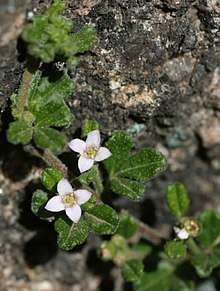Zieria obcordata
Zieria obcordata, commonly known as obcordate-leafed zieria, is a plant in the citrus family Rutaceae and endemic to New South Wales. It is an aromatic, densely branched, rounded shrub with small, hairy, three-part leaves and up to three white to pale pink flowers with four petals and four stamens arranged in the leaf axils. It occurs in two disjunct populations in the central-west of the state.
| Obcordate-leafed zieria | |
|---|---|
 | |
| Scientific classification | |
| Kingdom: | Plantae |
| Clade: | Tracheophytes |
| Clade: | Angiosperms |
| Clade: | Eudicots |
| Clade: | Rosids |
| Order: | Sapindales |
| Family: | Rutaceae |
| Genus: | Zieria |
| Species: | Z. obcordata |
| Binomial name | |
| Zieria obcordata | |
Description
Zieria obcordata is an aromatic, densely-branched, rounded shrub which grows to a height of 0.5 m (2 ft) and has hairy branches when young. The leaves are composed of three wedge-shaped to heart-shaped leaflets with the narrower end towards the base. The leaves have a petiole 1–3 mm (0.04–0.1 in) long and the central leaflet is 3–9 mm (0.1–0.4 in) long and 1–4 mm (0.04–0.2 in) wide. The upper surface of the leaflets is slightly warty and both surfaces are covered with simple hairs. The flowers are white to pale pink and are arranged singly or in groups of up to three in leaf axils, the groups shorter than the leaves. The sepals are triangular, about 2 mm (0.08 in) long and wide and hairy. The four petals are about 2 mm (0.08 in) long and sometimes hairy. Flowering occurs mainly in September and October and is followed in summer by fruit which are warty, hairy capsules.[2][3]
Taxonomy and naming
Zieria obcordata was first formally described in 1825 by Allan Cunningham and the description was published in Geographical Memoirs on New South Wales.[1][4] The specific epithet (obcordata) is derived from the Latin word cordata meaning "heart-shaped"[5]:231 with the prefix ob- meaning "towards".[5]:566
Distribution and habitat
This zieria grows in open shrubby woodland and on rocky hillsides in two disjunct populations near Wellington and near Bathurst. It often occurs with rough-barked angophora (Angophora floribunda) and hickory wattle (Acacia implexa) and weeping boree (Acacia vestita).
Conservation
Obcordate-leafed zieria is classified as "endangered" under the New South Wales Threatened Species Conservation Act and the Commonwealth Government Environment Protection and Biodiversity Conservation Act 1999 (EPBC) Act. The main threats to the species are weed invasion, inappropriate fire regimes, grazing and land clearing.[3]
References
- "Zieria obcordata". APNI. Retrieved 5 August 2017.
- Armstrong, James; Harden, Gwen. "Zieria obcordata". Royal Botanic Garden Sydney; plantnet. Retrieved 5 August 2017.
- "Zieria obcordata recovery plan" (PDF). Australian Government Department of the Environment. Retrieved 5 August 2017.
- Field, Barron (ed.); Cunningham, Allan (1825). Geographical Memoirs on New South Wales (Chapter 14). London: John Murray. p. 330. Retrieved 5 August 2017.CS1 maint: extra text: authors list (link)
- Brown, Roland Wilbur (1956). The Composition of Scientific Words. Washington, D.C.: Smithsonian Institution Press.
External links

